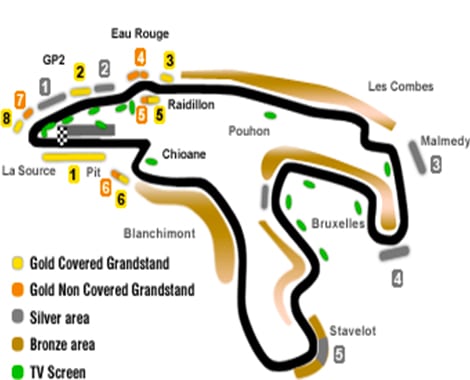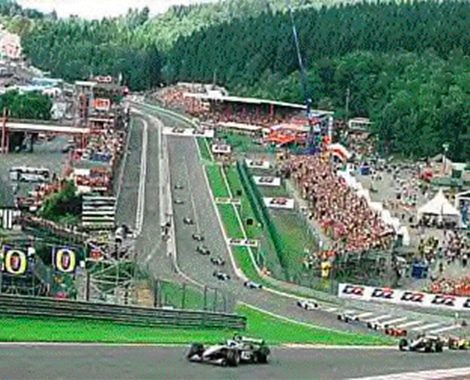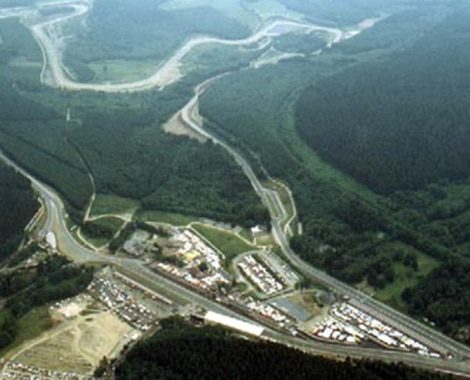2024 Belgium Grand Prix
2024 Belgian Grand Prix at Spa-Francochamps Belgium
2024 Belgium Grand Prix Dates - July 26-280 2024
As a USA based licensed Tour Operator we have been hosting guests at the Formula One Belgian Grand Prix at Spa, Belgium since 1982. Our great tickets, hotels and VIP travel packages to the 2024 Spa Belgium Grand Prix include your Official F1 Belgian Grand Prix race tickets, hotel accommodations, hospitality options and VIP transfers.
RESERVE NOW space is limited
Your 2024 Spa Belgium Belgian Grand Prix Experience
At the 2024 Belgian Grand Prix at Spa, Belgium, the setting is beautiful and the facility is one of the last remaining true natural circuits with part of the track utilizing a public highway. As a licensed USA Tour Operator we have been providing travel packages and tickets to the Formula One Spa Belgium Belgian Grand Prix since 1982. The Belgian Grand Prix 2024 facilities around the garages, pits and paddock are quite compact and it is easy to watch the action. Our 2024 Belgium Grand Prix at Spa package tickets for covered grandstand seats are in the most central locations with a great view of the Big Screen TV. (Gold 2) directly at the bottom of the downhill run to Eau Rouge or (Gold 7) at the hairpin right after the start. You see the cars as they exit the hairpin at “La Source” and scream down the hill toward you to “Eau Rouge” (Gold 3) plus great view of Big Screen TV or opposite the Pits (Gold 1). Enjoy your private VIP transfers only 45 minutes to the track each day and we park just a short stroll from your seats and close to all the Vending and Team Displays! Your 2024 F1 Belgian Grand Prix travel packages include your Brussels Belgium airport to hotel transfers, hotel to track transfers, hotel accommodations and Belgium Grand Prix 2024 race tickets.
RESERVE NOW so you don’t miss the 2024 Belgian Grand Prix at Spa!
2024 Belgium Grand Prix Dates
Arrive Friday, July 26 and depart on Monday, July 29, 2024
Arrive Thursday, July 25 and depart on Monday, July 29 2024
Maastricht Holland Hotels
both 3 and 4 Star
We offer hotel accommodations in scenic Maastricht Holland, located 1/2 way between the Brussels airport and the track at Spa-Francochamps. This quaint Dutch city offers lots of opportunity to stroll the cobblestone streets in the pedestrian area with shops, bars, cafes and restaurants. Both hotels feature modern guest rooms with air-conditioning. Maastricht is the perfect place for us to relax after an exciting day at the track!
Check with us for additional hotel options and availability
Click below For Your 2024 Belgium Grand Prix Itinerary
Optional Day 1 with Extra Day Arrival Thursday 4-night package
Day 1: Thursday: Arrive and be greeted by the Grand Prix Club staff at the International Airport in Brussels. Private transfers to your Hotel in Maastricht Holland where you can relax from your flight. Explore Maastricht and have dinner out or in our hotel.
Day 1: (3-night package)
Friday: Arrive and be greeted by the Grand Prix Club staff at the International Airport in Brussels. Private transfers to your Hotel in Maastricht Holland where you can relax from your flight. Explore Maastricht and have dinner out or in our hotel. Breakfast at our Hotel and then depart on our private transfer to Spa.
Day 2: (4-nights package) Friday – Spend the day watching two Formula 1 practice sessions plus support races from our great seats or enjoy Maastricht, Aachen or Liege (all within about 30 minutes). Private Vip transfers for the return to our hotel in Maastricht in the afternoon. Dine at the hotel or one of the many fine restaurants in town.
(B)
Day 2: (3-nights package)
Saturday: Breakfast at our Hotel and then departure on our exclusive private VIP transfers to Spa for Formula 1 practice session plus qualifying. Lots of other track activity all day. Private VIP Transfers back to our hotel in Maastricht in the afternoon and your evening free..
(B)
Day 3: (4-nights package)
Saturday: Breakfast at our Hotel and then departure on our exclusive private VIP transfers to Spa for Formula 1 practice session plus qualifying. Lots of other track activity all day. Private Vip transfers back to our hotel in Maastricht in the afternoon and your evening free.
Day 3: ( 3-nights package)
Sunday: Breakfast and then off on our private transfer to Spa for the Grand Prix. Private coach return to our hotel in the late afternoon and then enjoy your evening at one of the many fine restaurants in Maastricht.
(B)
Day 4: (4-nights package)
Sunday: Breakfast and then off on our private transfer to Spa for the Grand Prix. Private transfer return to our hotel in the late afternoon and then enjoy your evening at one of the many fine restaurants in Maastricht.
(B)
Day 4: (3-nights package)
Monday: Breakfast and then VIP transfers to Brussels airport for your return trip.
(B)
Day 5: (4-nights package)
Monday: Breakfast and then VIP transfers to Brussels airport for your return trip.
(B)
(B) = Breakfast
2024 Belgium Grand Prix 4 Day, 3 Night Options
Option A - 4 day 3 -nights
3 or 4 Star Hotel-
Friday Arrival
-
Brussels airport Transfers
-
2-day VIP Track Transfers
-
Single Occupancy 3 Star- FROM $3495 Per Person 4 Star $3995
-
Double Occupancy 3 Star- FROM $2995 Per Person 4 Star FROM $3495
-
Add Paddock Club tickets - $6495 Per Person
Click below for additional Options
2023 Belgium Grand Prix 5 Day, 4 Night Options
Option B - 5 day 4 nights
3 or 4 Star Hotel-
Thursday Arrival
-
Brussel Airport Transfers
-
3-day VIP track Transfers
-
Single Occupancy 3 Star $3595 Per Person 4 Star $4295
-
Double Occupancy 3 Star - $2995 Per Person 4 Star $3595
-
Add Paddock Club tickets - $4995 Per Person
Click below for additional Options
Still have questions?
Brief History of the track at Spa-Francorchamps Belgium for the Belgian Grand Prix
In 1922, the first car race was held at the circuit, and two years later the first running of the now-famous 24 Hours of Francorchamps race happened. It was in 1925 when the circuit was first used for Grand Prix racing.
The old Spa circuit was basically a speed course with drivers managing much higher average speeds than on other race tracks – a factor that made Spa very popular from the start.
The Belgians took pride in having an exceptionally fast circuit, so they cut short the former slow uphill U-turn at the bottom of the Eau Rouge creek valley (known as the Ancienne Douane) with a faster sweep straight up the hill (known as the Raidillon). Up until 2000, when the race track was still a public road, traveling to it was possible. At Eau Rouge, the famous uphill corner was allowed to be used by southbound traffic, while the downhill traffic had no other choice but to traverse the old road and take a U-turn behind the grand stands, until it eventually rejoins the race track at the bottom of Eau Rouge.
The old race track’s path carried on through the now-straightened Kemmel curves to the highest part of the track, then went downhill into a fast, slightly banked downhill left-hander towards Burnenville called Les Combes, passing the village in a swift right hand sweep. Close so Malmedy is where the Masta straight began, which was only interrupted by the fast Masta Kink amongst farm houses before reaching the town of Stavelot. Then the track ripped through an uphill straight section that has a few kinks called La Carriere, going through two ultra-fast turns before braking really hard for the La Source hairpin, which is where the downhill start-finish section rejoined, as opposed to where the start-finish section is located before La Source.
Much like the Nürburgring, Spa became notorious for fatal accidents. There have been many deaths at the ultra-fast track, especially at the 1960 Belgian Grand Prix where 2 drivers, Chris Bristow and Alan Stacey were both killed within 15 minutes.
In 1970 when Armco guard rails where added to the track, deaths became less frequent but the track was still notorious for other factors. Known for its very unpredictable weather, the Ardennes Forest had parts where it was raining and the track was wet, while on other parts the track was totally dry and the sun was shining. This factor was common on long circuits, but the weather at Spa was always more unpredictable than other long circuits, combined with the fact that it was an ultra-high speed track that has all but two of the corners (Eau Rouge and La Source) being very high speed made it one of, if not the most dangerous race track in the planet.
During the 1973 and 1975 24 Hours of Spa touring car races, there were multiple fatalities that eventually lead to the old circuit’s demise. And by 1978, the last year Spa was back in its original form, with the only major races being held there were the 24 Hours of Spa and the Belgian Motorcycle Race.
F1 boycotted the Belgian Grand Prix in 1969 because of the Spa’s extremely dangerous layout. A total of 10 fatalities had been recorded at the track in the 1960s, including 5 more in the previous two years. The drivers demanded that changes be made to the Spa, which were not achievable on short notice, prompting organizers to drop the Belgian Grand Prix that year. Similar to how Armco had been added for the 1969 Le Mans race, Armco was added to the track and some sections of it were enhanced. One last race there in 1970 on the improved track still was not satisfactory enough (even after a temporary chicane was added at Malmedy just for that race) for the drivers in terms of safety. F1 only returned to the Spa in 1983 when the modern track was operational.
Regarded as one of the most fearsome sections on any race track in the world, the Masta Kink requires skill and bravery in equal measure to execute correctly. After a lengthy run from Malmedy, the cars would be in top speed before having to deal with Masta, a high-speed left-right chicane, and a good exit speed was crucial as another long straight run to Stavelot comes after it. This was a notoriously dangerous corner because it was located between two very long unbroken straights both about 2.4 kilometers long (1 ½ miles).
After the 1970 race, Masta was finally lost to F1 racing. Jackie Stewart’s campaign to improve safety in the race track was set in action by his crash there in 1966, when his BRM tumbled upside-down in the cellar of a farmhouse situated on the outside of the corner, with fuel gushing out of the tank onto Stewart, who also suffered from broken ribs in the unfortunate mishap. By that point, a lot of the Formula One drivers, including Stewart and Jim Clark, immensely disliked Spa because of the high speeds that were persistent on the track. Stewart, while he was spectating at the 12 Hours of Sebring in 1972, attempted to organize a boycott of the Spa 1000 km race that year, a move which was not esteemed by many of the drivers as Spa was still fairly popular to them.
On the original configuration of the Spa-Francorchamps circuit, eighteen Formula One World Championship Grands Prix were run in total. The Spa course was subject to numerous modifications over the years. The track, which was originally 15 kilometers long, underwent a couple of changes after World War II. The chicane at Malmedy was removed and bypassed in 1930, making the course even faster, but the now slightly modified chicane was eventually reinstalled in 1935. Virage de Ancienne Douane was eliminated and cut short in 1939 – a move which gave birth to the Eau Rouge/Radillon uphill sweeping corner. Then in 1947, the chicane at Malmedy was eliminated and bypassed for the second time, and was made part of the Masta Straight. The minimal right-hander that was originally Holowell was eliminated. And finally, instead of having the drivers go through a slight left-hander that went into Stavelot and an abrupt right-hander at a road junction in Stavelot, a shortcut was added that turned into a very wide, very fast right-handed turn that bypassed Stavelot. Every change that was made turned the final configuration of the old Spa circuit into 14 kilometers long (9 miles), and all of them made Spa the fastest open road circuit in the world. In the old circuit’s final years, drivers could average up to 150 mph (241 km/h) on it. However, in 1979, the biggest change saw the circuit’s length being cut down from 14 kilometers (9 miles) to 7 kilometers (4 miles). In 1981, the start-finish line, which was originally situated before Eau Rouge, was transferred to the straight before the La Source hairpin. Similar to its predecessor, the new layout is still a fast and hilly route punching through the Ardennes, where speeds of up to 330 km/h (205 mph) can be reached. The place has been famous for its unpredictable weather since the beginning, so drivers frequently experience one stretch of the course being slippery and rainy while another part is completely clear and bright.
The circuit likely demonstrates the significance of the driver’s skill more than any other in the world. This is mostly because of the Eau Rouge and Blanchimont corners, both of which are required to be taken flat out to achieve a fast run onto the straights following them, which helps a driver in cases of overtaking and a fast lap.
The Eau Rouge / Raidillon combination is the most famous part of the circuit. After having negotiated the La Source hairpin, drivers barrel down a straight to the point where the track goes over the Eau Rouge stream for the first time, before being hurled steeply uphill into a sweeping left-right-left combination of corners with a blind summit. Technically speaking, the Eau Rouge corner is only the left-hander at the bottom. First introduced in 1939 to shortcut the original hairpin Ancienne Douane, the next right-hander that leads steeply uphill is called Raidillon. The corner demands a huge amount of skill from the driver to navigate well, and the long straight path ahead often creates good overtaking opportunities for the best drivers at the following “Les Combes” corner. The corner was previously tighter and narrower on the old circuit, but it was made wider when the circuit was updated in 1970.
In 1994, following the unfortunate deaths of Ayrton Senna and Roland Ratzenberger at the Grand Prix weekend at Imola, chicanes made of piles of tires were introduced to the following F1 races. The entry to Eau Rouge was obstructed this way in 1994, although it was returned to its previous glory the following year. And despite being slightly modified in 2002, the corner still retained its character.
Due to the introduction of a new legislative order in Europe, bans in tobacco advertising were imposed and Formula One was facing a major threat regarding sponsorship. Because of those political and legislative circumstances, the Belgian Grand Prix was left out of the 2003 schedule as a response to the internal tobacco legislation in Belgium. The event was tagged as a World Class event within the national senate and thus it was saved for the 2004 F1 season. The section known as the Bus Stop chicane was modified for 2004 with an additional sweep to the right.
Spa was again dropped from the f1 calendar in 2006. The organizer of the event went bankrupt in late 2005, and therefore the planned improvements to the track and paddock had not been made. The local government stepped in and provided the necessary funds, but too late for the 2006 race to take place.
From 2007, the amount of sponsors from the industry who find the sport appealing were limited due to tobacco advertising bans. As of 2010, only the Ferrari Team still had tobacco branding, however the team dropped the Marlboro “stripes” from their race cars after accusations of it being linked to subliminal advertising. In comparison, five teams, which were half of the total competing participants, sported tobacco branding on their cars in 2003.
With a new financial backer, renovations started on November 6, 2006 and finished in May 2007, costing around €19 million. Finally, with a modified track layout, Formula One returned to Spa in 2007. The La Source hairpin was moved forward and the Bus Stop chicane was moved back towards Blanchimont, allowing for more space for the new pit lane. The modifications gave a longer start/finish straight and included the current new F1 garage building and paddock area.
“For more information on Belgium visit www.visitbelgium.com, the official web site of the Belgian Tourist Office inthe Americas”




